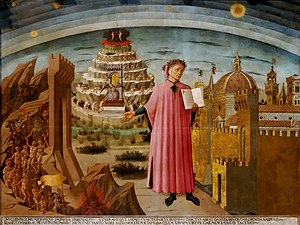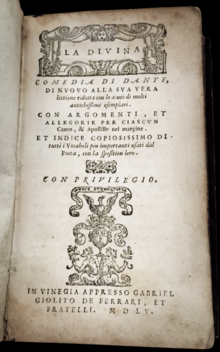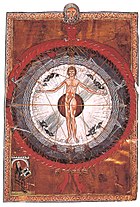Komedi Ketuhanan
Divina Commedia ([diˈviːna komˈmɛːdja]; berarti Komedi Ilahi) adalah puisi naratif yang panjang hasil karya Dante Alighieri, penulisannya dimulai tahun ca 1308 dan terselesaikan pada tahun 1320, satu tahun sebelum wafatnya pada tahun 1321. Puisi ini secara luas dianggap sebagai karya unggulan dalam sastra Italia,[1] dan dipandang sebagai salah satu karya terbesar sastra dunia.[2] Visiun imajinatif sang penyair tentang kehidupan setelah kematian merepresentasikan pandangan dunia abad pertengahan sebagaimana yang dikembangkan dalam Gereja Barat pada abad ke-14. Divina Commedia berkontribusi membentuk bahasa Toskano, yang digunakan dalam penulisan karya ini, sebagai bahasa Italia baku.[3] Karya ini terbagi menjadi tiga bagian: Inferno, Purgatorio, dan Paradiso.


| Bagian dari seri tentang |
| Mistisisme Kristiani |
|---|
 |
| Bagian dari serial tentang |
| Bahasa Italia |
|---|
| Sejarah |
| Sastra dan lainnya |
| Tata Bahasa |
| Alfabet |
| Fonologi |
Selayang pandang, puisi ini melukiskan perjalanan Dante melintasi Neraka, Purgatorium, dan Firdaus atau Surga;[4] tetapi, pada suatu tingkatan yang lebih dalam, puisi ini secara alegoris merepresentasikan perjalanan jiwa menuju Allah.[5] Pada tingkat yang lebih dalam itu, Dante merujuk pada filsafat dan teologi Kristen, khususnya fisafat Thomistik dan Summa Theologica karya Santo Thomas Aquinas.[6] Akibatnya, Divina Commedia menjadi disebut "Summa dalam rupa puisi".[7]
Karya ini pada awalnya hanya berjudul Comedìa dan kata Divina ditambahkan oleh Giovanni Boccaccio. Edisi cetak pertama yang menambahkan kata divina pada judulnya adalah yang dihasilkan seorang humanis Venesia bernama Lodovico Dolce,[8] diterbitkan pada tahun 1555 oleh Gabriele Giolito de' Ferrari.
Galeri
suntingDari Dialogo di Antonio Manetti, cittadino fiorentino, circa al sito, forma, et misure dello inferno di Dante Alighieri poeta excellentissimo (Firenze: F. Giunta, 1510?)
Lihat pula
suntingCatatan kaki
sunting- ^ (Inggris) For example, Encyclopedia Americana, 2006, Vol. 30. p. 605: "the greatest single work of Italian literature;" John Julius Norwich, The Italians: History, Art, and the Genius of a People, Abrams, 1983, p. 27: "his tremendous poem, still after six and a half centuries the supreme work of Italian literature, remains – after the legacy of ancient Rome – the grandest single element in the Italian heritage;" and Robert Reinhold Ergang, The Renaissance, Van Nostrand, 1967, p. 103: "Many literary historians regard the Divine Comedy as the greatest work of Italian literature. In world literature it is ranked as an epic poem of the highest order."
- ^ (Inggris) Bloom, Harold (1994). The Western Canon. See also Western canon for other "canons" that include the Divine Comedy.
- ^ (Inggris) See Lepschy, Laura; Lepschy, Giulio (1977). The Italian Language Today. or any other history of Italian language.
- ^ (Inggris) Peter E. Bondanella, The Inferno, Introduction, p. xliii, Barnes & Noble Classics, 2003, ISBN 1-59308-051-4: "the key fiction of the Divine Comedy is that the poem is true."
- ^ (Inggris) Dorothy L. Sayers, Hell, notes on page 19.
- ^ (Inggris) Charles Allen Dinsmore, The Teachings of Dante, Ayer Publishing, 1970, p. 38, ISBN 0-8369-5521-8.
- ^ (Inggris) The Fordham Monthly Fordham University, Vol. XL, Dec. 1921, p. 76
- ^ (Inggris) Ronnie H. Terpening, Lodovico Dolce, Renaissance Man of Letters (Toronto, Buffalo, London: University of Toronto Press, 1997), p. 166.
Pranala luar
sunting- (Inggris)Templat:Ita Princeton Dante Project Diarsipkan 2009-06-03 di Wayback Machine. Website that offers the complete text of the Divine Comedy (and Dante's other works) in Italian and English along with audio accompaniment in both languages. Includes historical and interpretive annotation.
- (Inggris) The Comedy in English: trans. Cary (with Doré's illustrations) (zipped HTML downloadable from Project Gutenberg), Cary/Longfellow/Mandelbaum parallel edition Diarsipkan 1999-04-20 di Wayback Machine., trans. James Finn Cotter Diarsipkan 2018-04-14 di Wayback Machine.
- (Italia) Full text of the Commedia: [1]
- (Inggris)(Latin)(Italia) Dante Dartmouth Project: Full text of more than 70 Italian, Latin, and English commentaries on the Commedia, ranging in date from 1322 (Iacopo Alighieri) to the 2000s (Robert Hollander)
- (Inggris) On-line Concordance to the Divine Comedy Diarsipkan 2009-05-10 di Wayback Machine.
- (Inggris) A Dictionary of the Proper Names and Notable Matters in the Works of Dante by Paget Toynbee, London, The Clarendon Press (1898).
- (Inggris) Online manuscript codices: Phillips 9589
- (Inggris) Danteworlds, multimedia presentation of the Divine Comedy for students by Guy Raffa of the University of Texas
- (Inggris)(Italia) World of Dante Multimedia website that offers Italian text of Divine Comedy, Allen Mandelbaum's translation, gallery, interactive maps, timeline, musical recordings, and searchable database for students and teachers by Deborah Parker and IATH (Institute for Advanced Technologies in the Humanities) of the University of Virginia
- (Inggris) Images of the 1564 edition of Divine Comedy First edition to contain both the commentaries by Landino and Vellutello published by Francesco Sansovino
- (Inggris)(Italia) bilingual (Italian and English)Divine Comedy in pdf format in Online Library of Liberty
- (Inggris) More images of the Divine Comedy by selecting the "Heaven & Hell" subject at the Persuasive Cartography, The PJ Mode Collection, Cornell University Library
- (Inggris) Mapping Dante: A Study of Places in the Commedia Digital interactive map with the geographical references of the Divine Comedy
- Audio
- (Inggris) Lino Pertile's reading Diarsipkan 2020-06-16 di Wayback Machine., Professor of Romance Languages and Literatures, Harvard University.
- (Inggris)(Italia) Buku audio domain publik Divine Comedy di LibriVox
- (Italia) Readings of the complete Italian Divina Commedia in MP3 format by Iacopo Vettori
Templat:Divine Comedy navbox Templat:Dante Templat:Francesca da Rimini